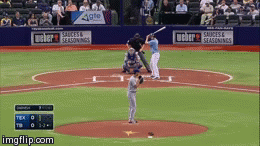
Decade and MLB consultant for over two decades) and Fred Claire (World Series-winning general
manager of the Los Angeles Dodgers and member of the club’s front office for 30 years.)
Media is welcome to use this information. We would ask for a reference and, if possible, a link to AriBall.com. ###
 |
 |
Left Image: Swings and Misses in 2014 Right Image: Swings and Misses in 2013
If we look at comparables with a less than 30% O-Swing% and less than 60% O-Contact%, these players in 2014 include Josh Donaldson, Matt Kemp, and Lucas Duda, who are known more for their power than their contact percentages. Myers has exhibited the home run numbers at the minor league level on a full season basis with a career high 37 home runs in 2012 between AA and AAA and in a short sample size with 13 home runs in his 2013 campaign. The main question he has to answer is, whether he will hit for the power that was expected of him in 2014. In 2013, his numbers were definitely inflated with a high-batted balls in play average (BABIP) of .362 and a regression was definitely expected. Still, even before his wrist injury on June 1st, his 2014 campaign was marred with low OPS numbers of less than .700. With low contact percentages (contributed by low O-Contact%) and high strikeout rates of above 20%, it is hard to distinguish whether his breakout 2013 season was a fluke or if the 2014 season as a whole was a wash.
Source: imgflip
Wil Myers is an intriguing player with the potential to be a budding star in the league. He clearly exhibits the physical traits and a sweet swing to be an everyday player in a corner outfield spot. In 2013, it was plain obvious that he excelled with a .293 batting average, .354 on-base percentage, and a .478 slugging percentage. Still, regression was most likely to occur and did occur because of the regression of his high-batted balls in play (BABIP) number of .362 in 2013 to .286 in 2014. However, Myers also suffered from a nagging wrist injury for most of the season, which is a reason for a huge drop in his power numbers, especially his line drive rate of 20.2% in 2013 to 15.6% in 2014. In the case of San Diego Padres, he was the perfect buy-low candidate because his third year in the league will really show if Myers can be a star. At the minor league level, he has shown the ability to be relatively patient at the plate with two years of 10% or more walk rates from 2012 to 2013. However, his high strikeout rate and low walk rate brings about questions about his progression in the future. From the zone profiles of Wil Myers in 2013 and 2014, one can really see that he shows some skill in his strike-zone recognition because he does not swing at a whole lot of bad pitches as his high career strikeout rate would suggest (<= 30% in Outside Swing %). Yet, his low contact numbers can be mainly attributed to his low outside contact percentages. If I were to hypothesize the main culprit for his struggles in 2014, I would probably assume that his wrist was not 100% when he came off the 60-day DL. In general, the 2014 campaign should be considered a wash for Wil Myers, but you still have to wonder where the power was in the 224 plate appearances before the injury. To really gain a better gauge for his expected performance at the major league level, a larger sample size is needed. In that case, the 2015 campaign will be the telling sign of Wil Myers’ true value because it will be his first full season at the major league level. It cannot be questioned that his high strikeout rates (>= 20% in 2013 and 2014) in the majors are a cause for concern if he is not able to deliver on power. In the case of the Padres, the acquisition of Wil Myers is a risk because of a small sample size of success in 2013. Heading into his age 24 season, Myers is still so young, and the game probably has not slowed down for him. In addition, in a 2014 Rays lineup, he was expected to carry a lot of weight as a power bat on a team that was near the bottom 10% of the league in home runs, OBP, and OPS. Steamer projects a 2015 campaign of 18 home runs with an OPS of .734 for Myers, which sounds about right for a player that could potentially see a normalized BABIP of .300 to .310 in 2015. For further development into a 20-25 home run hitter will depend on Myers’ approach to the plate going into the future. Yet, the future still looks bright for Wil Myers, who won’t be depended on as a number one power hitting option as he enters an ever-improving Padres lineup that currently features (at the moment) Matt Kemp and Justin Upton.
NOTE: All statistics accurate as of 12/22/14
By Sanjay Pothula


In this case, you can see that Yu Darvish was set to throw a two-seam fastball down in the zone. In the second frame, he missed high and out of the zone. Myers chased and missed for a strikeout. His ability to protect when behind in the count significantly regressed from 2013 (.276 BA and .716 OPS) to 2014 (.165 BA and .348 OPS).
AriBall.com


